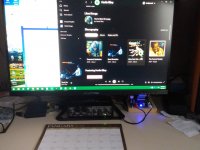It's a nice unit. Detailed and soft all at the same time. Cleaner highs and there are details I haven't heard before. Bells, chimes, and whistles are very clear. The soundstage is deep. Not as wide though. Lots of gain so I'm using passive volume control.
Our Class A's sit for now.
This unit replaces 4 other Class D modules we have.
Our Class A's sit for now.
This unit replaces 4 other Class D modules we have.
Finally had time to mount the FFA001_V3 on a board and solder up the connections. Dug out a couple of my Cornu speakers from storage and hooked them up just in case. Drove the amp with a Sansa Clip+ and it sounded great on Stanley Turrentine, Pat Metheny & Charlie Haden, and Poncho Sanchez. So I moved it over to my main computer rig where I spend a lot of time; the speakers are Focal 7" kevlar woofer and titanium tweeter in a Zalytron cabinet from 25 years ago and are fabulous 2-ways. I knew the amp has high gain so I turned every adjustment to zero before turning it on. My dac is a usb headphone adapter, super hi resolution. So I turned down windows master volume, the mixer volume for spotify and spotify's native volume control. For some reason my audio device (headphone dac) took a vacation and I couldn't bring it up. Instead I saw my monitor as audio device(!) Anyway I turned the amp on with Michael Brecker queued up and was blasted out of my seat by the full power of this thing. OMG! Shut it down in microseconds. I checked that all volumes were set to zero and tried a couple of more times with the same results. By now I was impressed that my speakers were still working because this was the loudest sound I've ever experienced and I've been drumming for over 6 decades. Eventually thru Control Panel/Sound I found a headphone level and turned that from 100 to 20% and that did the trick. Phew. Everything works. The amp is great. Balanced nicely like others have commented. I'm getting a nice soundstage as well. Really terrific dynamics and absolutely silent in between songs. My monitor is still listed as audio device 🙄 Probably a reboot will fix it but I'm too engrossed by the music. Thanks Eric.
Your taste in music is similar to mine. I wonder how the amount of gain could be reduced? For me that’s a deal breaker.Finally had time to mount the FFA001_V3 on a board and solder up the connections. Dug out a couple of my Cornu speakers from storage and hooked them up just in case. Drove the amp with a Sansa Clip+ and it sounded great on Stanley Turrentine, Pat Metheny & Charlie Haden, and Poncho Sanchez. So I moved it over to my main computer rig where I spend a lot of time; the speakers are Focal 7" kevlar woofer and titanium tweeter in a Zalytron cabinet from 25 years ago and are fabulous 2-ways. I knew the amp has high gain so I turned every adjustment to zero before turning it on. My dac is a usb headphone adapter, super hi resolution. So I turned down windows master volume, the mixer volume for spotify and spotify's native volume control. For some reason my audio device (headphone dac) took a vacation and I couldn't bring it up. Instead I saw my monitor as audio device(!) Anyway I turned the amp on with Michael Brecker queued up and was blasted out of my seat by the full power of this thing. OMG! Shut it down in microseconds. I checked that all volumes were set to zero and tried a couple of more times with the same results. By now I was impressed that my speakers were still working because this was the loudest sound I've ever experienced and I've been drumming for over 6 decades. Eventually thru Control Panel/Sound I found a headphone level and turned that from 100 to 20% and that did the trick. Phew. Everything works. The amp is great. Balanced nicely like others have commented. I'm getting a nice soundstage as well. Really terrific dynamics and absolutely silent in between songs. My monitor is still listed as audio device 🙄 Probably a reboot will fix it but I'm too engrossed by the music. Thanks Eric.
I have a two channel interface with Mic pres and RCA inputs designed for recording. I'm thinking of using that as the DAC because it has a volume control. In the meantime I went back to my AIYIMA A8 which has a merus infineon chip. But it doesn't have near the dynamics. Also I like to run all my computer stuff near maximum gain, so I need some other way to cut the signal before it gets to the power amp. The interface would do it.
Does adding a volume pot to your amp case at the module's input not help?........ so I need some other way to cut the signal before it gets to the power amp. The interface would do it.
Having a DAC preamplifier with volume control will be good for this pure power amplifier.I have a two channel interface with Mic pres and RCA inputs designed for recording. I'm thinking of using that as the DAC because it has a volume control. In the meantime I went back to my AIYIMA A8 which has a merus infineon chip. But it doesn't have near the dynamics. Also I like to run all my computer stuff near maximum gain, so I need some other way to cut the signal before it gets to the power amp. The interface would do it.
Thanks,Eric
I think the 700W @ 8ohm bridge mono output may come first~Thanks for the info, Eric. I really need a big amp with on board PSU. 600w @4R would be a start, but I would be much happier with close to 1kw @4R. This is nothing about more power for more output, but rather a marketing decision to honestly list a tremendous power figure on my flagship bass amp, I have access to one such 1kw amp at the moment, but I like your style and would rather get these things from you
I have a use for the FFA002 if it can do 700w @8R in bridge mode for my school model bass amp
I also have a use for the FFA001 high/bass model in the budget model bass amp
If you have marked the FFA002 for further development like black sinks and such, then I'll pass on it for now and order the high/bass amp and work and that model for now. Let me know if you would also prefer to see evaluation of the high/bass rather than the FFA002 at this stage
With the FFA003, how hard would it be to develop it to a full 2R capability and make it a true heavy-duty module in another way?
And yes, I would like to please order one of those modules. Just not sure which one to pick first
Thanks and regards
Randy
Have the PP samples now, and ready for test 🙂
Thanks,Eric
Last edited:
Why are your heatsinks mounted this way?With this kind of power I would prefer the fins being vertically to dissipate more heath, like you have on the other modules.I think the 700W @ 8ohm bridge mono output may come first~
Have the PP samples now, and ready for test 🙂
View attachment 1126545
Thanks,Eric
Your volume settings on Spotify in the right lower part of your screen seems to be set to max..
It’s a very powerful amp (150W) for near field, maybe a 5W ACA mini would of been better suited for your needs.
I also use Spotify and I set the volume of my sound card to about 30% and I then fine tune with the volume from Spotify.
I use headphones but the same will work for your application.
Give it a try.
It’s a very powerful amp (150W) for near field, maybe a 5W ACA mini would of been better suited for your needs.
I also use Spotify and I set the volume of my sound card to about 30% and I then fine tune with the volume from Spotify.
I use headphones but the same will work for your application.
Give it a try.
... Also I like to run all my computer stuff near maximum gain, so I need some other way to cut the signal before it gets to the power amp. ...
So, I was wondering about this - is there a general rule about where the volume cuts occur and the outcome?Your volume settings on Spotify in the right lower part of your screen seems to be set to max.. ...
As in: should the source be maxed for volume, keeping the amplifier as low as possible to preserve headroom for dynamic power (if that is actually factual/practically useful)?
I expect the answer is [whichever has the least distortion/noise], but is there a general rule of thumb for commodity equipment (like Android phones and <$500 DAC, amps, and other equipment) about which is more likely? Or is it a crap-shoot?
Actually, I have been going the opposite of bonjonno, I was keeping my phone (either 3.5" headphone or BT) volume about 1/2 way and using the amp to control volume (variously going to active speakers, A07, or two old salvaged Denon AVR).
Thanks e. I know all about the various volume controls and in fact had to use the Spotify volume control for manipulation before I hooked up the interface. The latest problem is that the USB interface causes the PC not to be able to hibernate. I went through all the various power options and can only get it to sleep. So as much as I like this amp, it's just one problem after another. I have too many amps as it is and can easily go back to one of them. But I really like the sound of this amp.Your volume settings on Spotify in the right lower part of your screen seems to be set to max..
It’s a very powerful amp (150W) for near field, maybe a 5W ACA mini would of been better suited for your needs.
I also use Spotify and I set the volume of my sound card to about 30% and I then fine tune with the volume from Spotify.
I use headphones but the same will work for your application.
Give it a try.
I was always concerned about digital attenuation, in some cases it reduced the resolution. You can always add a fixed resistor attenuation and if you use quality resistor there is no real down side. Here is a good read on it.
https://www.electronics-tutorials.ws/attenuators/attenuator.html
https://www.electronics-tutorials.ws/attenuators/attenuator.html
Hi George, could you give us a short comment with the measurements to explain if they represent good or bad design decisions. As the mains and transformer are on this board that lacks any safety certification, i would like to understand if your finding reflect a sound and safe design or a potential safety hazard. Also, would it be safe to use metal mounts in all the mount points ( other than the floats) to a metal enclosure or some of them have to be mounted with non conductive attachment.TksA few observations relating to grounding after probing around the FFA001-V3 module. They are in agreement with stryx posting https://www.diyaudio.com/community/threads/2x150w-amp-module-for-sale.388868/post-7212954
Please see attachment 1 and 2
Main board:
There is no direct (DC) connection between any of the mounting holes.
Hole #9 is directly connected to the PCB ground. Thus there is also 0 Ohm between this hole and:
Negative speaker cables (P2 connector pins 2, 4)
J1 connector pins 3, 19, 20, 23, 24
Hole #1 is capacitively connected to Live and Neutral AC mains input (P1 connector, pins 1, 3) through 1nF capacitors. It serves as the grounding connection for the mains LP input filter.
There is a 300pF capacitance measured between this hole and PCB ground (Hole #9). I don’t know if it is due to a real capacitor (component) or it is parasitic.
Holes #2, 3, 8, 10 DC float. Holes #2, 3, 8 measure 860pF to Hole #9 (smd capacitors on each) and 220pF to Hole #1. Hole #10 measures 0pF to both Hole #9 and Hole #1
RCA input buffer board:
Buffer board is connected to the main board through the ribbon cable. It’s ground plane is an extension (0 Ohm) of the main board general ground.
Holes #4, 7 DC float. They measure 0pF to ground.
Holes #5, 6 are shorted together. Each is connected to ground through an 820 Ohm resistor in parallel to a small capacitor, thus they measure 410 Ohm to ground.
Input RCA barrel is each connected to ground through a 0 Ohm smd resistor
George
Last edited:
We changed the mounting style for the MOSFET with clip, so the heatsink fins cannot be vertical.Why are your heatsinks mounted this way?With this kind of power I would prefer the fins being vertically to dissipate more heath, like you have on the other modules.
The modules are small enough to mount vertically.We changed the mounting style for the MOSFET with clip, so the heatsink fins cannot be vertical.
Hi FraborHi George,
IMO, all and any bare SMPS board connected to mains voltage is potentially dangerous to work with. No safety certification either on component or board level can change this.
Conformance to safety and RF emission standards is the subject of testing the assembled (wired) and encased unit.
I am an amateur and I find it hard to implement a double insulated assembly. I opt to use metal enclosure with the protective earth (PE) permanently attached to the chassis.
If the signal input was balanced differential, I would connect all the mounting holes to PE as there is not much room for head scratching, only I should mind “the Pin 1 problem”.
With single ended unbalanced input, Eric design of the board grounding through some of the mounting holes offers the flexibility to deal with ground loop problems on connecting the board to different audio systems.
What is good for one system may not be appropriate for another.
Electricity safety rules don’t deal with noise due to ground loops btn audio equipments.
EMC mandate requires hole 1 to be connected to PE (this inevitably increases the leakage current and adds a bit of dirt on the noise floor).
Safety against fault currents requires hole 9 to be connected to PE either directly or through a low voltage level barrier (the anti-parallel diodes//resistor//capacitor), whichever gives the cleaner noise floor.
Hole 5, 6 are indifferent to safety concerns, only to ground loop issues. Check the noise floor with those connected or disconnected from PE. Holes 2, 3, 4 , 7, 8, 10 are floating themselves. No safety and no ground involvement.
Buzz and hum are monitored across the output terminals (with load connected) through oscilloscope or soundcard (these are more sensitive). Both are much more resolving than the “ear over the loudspeaker cone” for deciding on the optimum grounding connections.
Attached are some screenshots from different grounding connections of the board on my test bench (REW’s FFT)
George
Attachments
-
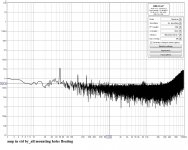 amp in std by_all mounting holes floating.jpg158.8 KB · Views: 141
amp in std by_all mounting holes floating.jpg158.8 KB · Views: 141 -
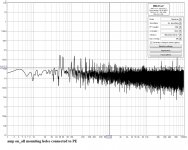 amp on_all mounting holes connected to PE.jpg167.9 KB · Views: 110
amp on_all mounting holes connected to PE.jpg167.9 KB · Views: 110 -
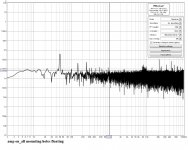 amp on_all mounting holes floating.jpg159.7 KB · Views: 113
amp on_all mounting holes floating.jpg159.7 KB · Views: 113 -
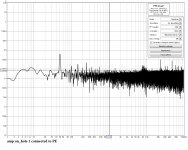 amp on_hole 1 connected to PE.jpg160 KB · Views: 107
amp on_hole 1 connected to PE.jpg160 KB · Views: 107 -
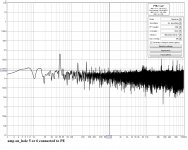 amp on_hole 5 or 6 connected to PE.jpg162.2 KB · Views: 105
amp on_hole 5 or 6 connected to PE.jpg162.2 KB · Views: 105 -
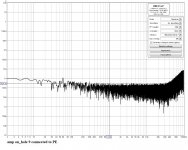 amp on_hole 9 connected to PE.jpg156.9 KB · Views: 109
amp on_hole 9 connected to PE.jpg156.9 KB · Views: 109 -
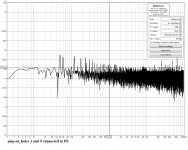 amp on_holes 1 and 9 connected to PE.jpg165.5 KB · Views: 108
amp on_holes 1 and 9 connected to PE.jpg165.5 KB · Views: 108 -
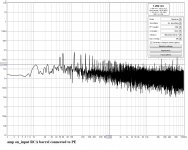 amp on_input RCA barrel connected to PE.jpg169.2 KB · Views: 144
amp on_input RCA barrel connected to PE.jpg169.2 KB · Views: 144 -
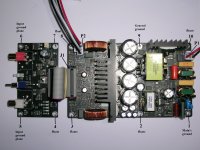 mounting holes.jpg636.7 KB · Views: 173
mounting holes.jpg636.7 KB · Views: 173
Last edited:
So, is this the takeaway?Hi Frabor ... George
Balanced inputs:
Connect all the mounting holes to PE.
-- But what is “the Pin 1 problem”?
Unbalanced Inputs:
If no ground loop issues: Connect all the mounting holes to PE.
If ground loop issues occur:
- Required to connect Hole 1 to PE -- EMC mandate.
- Required to connect Hole 9 to PE -- Safety against fault currents. This can be direct or through a low voltage level barrier, whichever gives the cleaner noise floor.
- Optional to connect Holes 5, 6 - No safety issues, but may resolve ground loop or noise floor issues.
- No need to connect Holes 2, 3, 4 , 7, 8, 10 -- No safety and no ground involvement.
-- Is there a reference for how to construct a "low voltage level barrier (the anti-parallel diodes//resistor//capacitor)" if required/desired?
Last edited by a moderator:
Hi Canon-Fodder 😎
I would start by connecting hole 1 and hole 9 to PE.
If buzz occurs, I would replace direct connection of hole 9 to PE with the anti-parallel diodes//resistor//capacitor to PE. This should cure the problem (*)
Then I would try to connect holes 5, 6 to PE. If they intoduce noise, I would keep them isolated.
(*) The earthing problem may very well exist within the other audio equipment that is connected to this amplifier. At that point, I would revisit the other equipment for inspection before getting frustated with this amplifier.
Now, Pin 1 problem:
https://www.ranecommercial.com/legacy/pdf/ranenotes/Pin_1_Revisited.pdf
In short: Pin 1 to be connected to chassis and not to system ground
About the anti-parallel diodes//resistor//capacitor:
Section 9, Figure 5 and accompanying text
https://sound-au.com/earthing.htm#s9
George
I would start by connecting hole 1 and hole 9 to PE.
If buzz occurs, I would replace direct connection of hole 9 to PE with the anti-parallel diodes//resistor//capacitor to PE. This should cure the problem (*)
Then I would try to connect holes 5, 6 to PE. If they intoduce noise, I would keep them isolated.
(*) The earthing problem may very well exist within the other audio equipment that is connected to this amplifier. At that point, I would revisit the other equipment for inspection before getting frustated with this amplifier.
Now, Pin 1 problem:
https://www.ranecommercial.com/legacy/pdf/ranenotes/Pin_1_Revisited.pdf
In short: Pin 1 to be connected to chassis and not to system ground
About the anti-parallel diodes//resistor//capacitor:
Section 9, Figure 5 and accompanying text
https://sound-au.com/earthing.htm#s9
George
Last edited:
- Home
- Vendor's Bazaar
- 2x150W Amp module for sale
